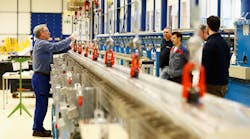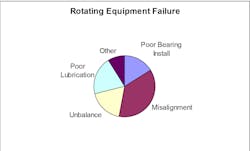In the Maintenance & Reliability community, we discuss at length strategies and methods for preventing and predicting machine failure. There are many presentations, books, and consultants available to teach the strategies for predictive and reliability-centered maintenance programs.
This short tutorial offers six basic tactics for use in any maintenance program to further aid in the prevention of machine failure.
According to the U.S. Department of Commerce, there are approximately 12.4 million electric motors, 1 horsepower and above, currently operating in industrial facilities in the United States. Close to 25% of these motors will fail this year. These tactics will help any company save money on maintenance by ensuring fewer machine failures.
Operations will make money because there will be less production loss, downtime, and scrap. Motors will run more efficiently, saving money on energy consumption and the reduction of the greenhouse gas footprint. As legislation is introduced that taxes pollutants, toxic materials, and harmful emissions, organizations that reduce such issues will also reduce potential punitive costs.
Training, Documentation, Commitment
“Unless commitment is made, there are only promises and hopes... but no plans.” – Peter Drucker
A common thread through all of these tactics will be training, documentation, and commitment. Everyone involved needs to be trained, not only on how to perform these essential tasks but also on why it's important. Documentation will ensure that they do it correctly, every time. Commitment to follow through will keep the program going and produce long-term results.
Training is readily available in our industry. Manufacturers and consultants offer on-site and classroom training for all of the disciplines we will be discussing. Do your homework and investigate your training options. Make sure you know what you want and what you are getting. Do you want training on how to use a certain product or do you want training to teach the entire process? Ask the potential trainer for a course synopsis and make sure it covers the topics you need. Ask the trainer if they're a practitioner.
“Excellence is an art won by training and habituation” – AristotleDocumentation is essential. It has been often said that people only respect what others inspect. Training ensures that things are done correctly and on time. Documentation can serve to highlight areas where more training is needed. It also provides a maintenance history for each piece of equipment that can be valuable when troubleshooting a particularly bad actor. And, sorry to say, documentation provides proof that the task was actually performed.
Commitment means buy-in from every level—from the maintenance reliability professional to management. Commitment to make sure tasks are performed to schedule, commitment to providing proper training, and commitment to not end the program prematurely if results do not come fast enough. There are short-term benefits to be had from using these tactics, but in the end, this is a long-term strategy.
The Top Five
This chart identifies the main causes of failure in rotating equipment. Predictive programs can identify these problems, but training and commitment to do things right the first time, every time will reduce them significantly. Commitment to eliminating these problems will improve the life cycle of any machine. If you are looking for a way to start improving your machine reliability, get committed to eliminating these problems.
1. Precision Alignment
“Industry worldwide is losing billions of dollars a year due to misalignment of machinery” – John PiotrowskiMisalignment is the #1 cause of machine failure. Misalignment occurs when the center lines of two shafts are not co-linear. Misalignment destroys bearings, seals, couplings, rotors, stators, shafts, etc. Misalignment of the driving and driven shaft(s) in a machine train adds stress forces to the shafts, which are transferred to the bearings, seals, etc. These forces work against all of these components to reduce the productive life of the machine.
Misalignment will also create high levels of vibration and friction. This can result in excess heat that can reduce the effectiveness of the lubricant. Excess vibration will result in shorter machine life and, in some cases, poor product quality resulting in scrap and waste.
Misalignment can be diagnosed using vibration analysis tools. There are distinct patterns that reveal the presence of misalignment:
- Angular misalignment is characterized by high axial vibration caused by the push/pull movement of the misaligned shafts
- Offset misalignment is characterized by high radial vibration
- Misalignment typically appears in the spectrum at 1 and 2 times running speed
There are many programs that still insist that a straight edge is sufficient for aligning two machines at the coupling. This may be acceptable for a rough alignment, but it's no replacement for a precision alignment tool.
Dial indicators can be a precise way to align shafts, but you must be well-trained in the methods and the math. Laser alignment tools are a faster alternative to dial indicators. They are easy to learn with the proper training. Laser tools take the guesswork out of the alignment process by displaying the offset and angle of the shafts and calculating the necessary moves to correct the problem. While dial indicators are less expensive, laser tool kit prices have been coming down and are now a very affordable alternative.
Whatever tool you choose to use to correct misalignment, you still need to get alignment training. The tools are only measuring units. They show the misalignment and the necessary corrections, but they don’t align the machine. Good alignment training includes more than just the how and when and why of using the measuring tool. Good training teaches the fundamentals, math, and theory of misalignment, as well as, good strategies to use to align machines of all 3 sizes, and includes hands-on training. Make sure your trainer has real-world alignment experience.
Good documentation is important in alignment. It's a record of who performed the alignment, when it was done and how well it was done. Documentation will also point out where additional training is required. Proper documentation should be electronic to prevent anyone from altering the document.
The commitment for alignment is to do it every time a machine is installed and make it a regular preventative maintenance step when machines are inspected. A quick alignment measurement can save a lot of headaches down the road.
2. Imbalance
“Mass imbalance is at the top of the list because it's the most common cause of vibration and the easiest to diagnose” – Victor WowkThink of imbalance as an imaginary heavy spot on a rotating shaft. This heavy spot is pulling the shaft and the center of rotation of the center line of the shaft on every rotation. The force of the imbalance is transferred to the bearing and case of the machine causing heat, friction, lubrication failure, and bearing faults. Extreme imbalance can cause looseness in the machine train.
There are many reasons for imbalance to be present in a rotor.
Deposit and build-up causes imbalance as deposits of dirt and grime build up on a rotor and its parts over time. The build-up of these deposits may be gradual, but not necessarily equal and can cause an imbalance condition. While the build-up may be gradual, the deposits will break away at an uneven rate causing a more serious imbalance. This can be especially true of fan blades. Fan blades will tend to collect deposits in a linear fashion, but the deposits will not come off in the same manner. They will come off in unequal pieces causing serious imbalance.
Make cleaning of the rotor, rotating parts, and fan blades a regular part of your scheduled inspection and preventative maintenance.
Rotors can also be damaged when exposed to abrasive or corrosive materials. This will cause uneven wear and an imbalanced condition. When you choose products, make sure their rotors are made from materials that can withstand corrosion and abrasion over long periods of time.
Eccentricity exists when the true or geometric centerline of a part does not coincide with its rotating center. This can be a manufacturing defect. Eccentricity can also be caused by out-of-roundness of the shaft, variations in electrical properties or uneven heating. With proper training, eccentricity can be measured with dial indicators.
Imbalance is characterized in the vibration spectrum by a dominant 1 times peak. Imbalance can be corrected in the field with balancing tools and proper training.
Special measuring tools and training are required to detect and correct imbalances. A best practice for helping prevent imbalance is to require all motors coming into your facility, whether new or rebuilt, to have a certificate of balance included. Set a standard and make your suppliers live up to it with documentation.
Make sure all of your millwrights, mechanics, and technicians are trained to recognize and correct imbalances in the equipment they are responsible for.
3. Lubrication
“When it comes to oil analysis and lubrication, it goes without saying that execution beats brilliance.” – Jim FitchLubrication is huge. Lubrication is used in rotating equipment to reduce friction between surfaces, prevent corrosion and wear and prevent contamination from outside sources. The proper lubricant at the proper schedule will allow the bearing to achieve its expected life and protect the inside of the machine from contaminants. This can be especially important in pumps where we don’t want contaminants in whatever we are pumping.
Too often we hear that if a little lubrication is good, then a lot is great. In truth, over-lubrication is just as bad as under-lubrication. Ask any motor shop and they will tell you that many of the failed motors they get in for repair are packed end to end with grease. In the end, as most electric motors are air-cooled, they just overheat and die.
Training is paramount for proper lubrication. The wrong type of lubricant is just as bad as too much or too little. Machines should be tagged (color codes work well) with the type of lubricant required, the lubrication schedule and/or frequency, and the amount of lubricant to be added each time.
The commitment with lubrication is to document the lubrication requirements of your machines and commit to a lubrication schedule. Lubrication technicians need to know the requirements and schedule of the machines for which they are responsible.
Most machines come with this information. It is also included with bearings, so if you change the bearing type, you may have to change your lubrication process for that machine. Keep good records and know what the requirements are for each machine and bearing. Document the type, amount, and frequency of lubrication for every machine.
More advanced lubrication programs will add ultrasound to their lubrication process. The consistent use of ultrasound in a lubrication program—from baseline to route-based activities—will allow the bearing to tell you when it wants to be lubricated, a condition-based response instead of a time-based response. An ultrasound tool used during lubrication will tell you when there is enough lubrication and prevent over-lubrication—the #1 cause of bearing failure.
This is another tool that requires training, documentation, and commitment.
4. Bearing Installation
As we saw in our earlier chart, improper installation of bearings causes upward of 16% of all bearing failures. These problems can arise from poor fitting, the use of brute force, and not having the correct mounting tools and methods.
Let’s look at the basic things you need to keep in mind for proper bearing installation.
How the bearings are stored and handled is a huge consideration. Rolling bearings should be stored in a cool, low-humidity environment that is free from shock, vibration, and dust. Poor storage conditions can cause defects to the bearing races before the bearing is ever used. Stored bearings should also be rotated periodically to prevent wear in one spot. Simply, the most effective bearing maintenance is to keep it clean.
Prior to mounting a new bearing, check the bearing housing and shaft to make sure they are clean and not damaged. Also, check the shaft and housing for out-of-round and taper. Use the tables supplied by the bearing manufacturer to ensure that the correct amount of clearance will be present when the bearing is installed. Make sure you are replacing the old bearing with one that is identical.
The lubricant must be clean and of the correct specification. Have the correct tools and equipment on hand and keep the work area clean.
Don’t remove the bearing from its wrapping until it's time to install and do not wash the bearing. Make sure you know what method will be required to mount the bearing.
Mechanical mounting methods are acceptable for small bearings. Always use the correct mounting tools (as opposed to a sledgehammer) and apply “minimum force with maximum control”. Never strike the bearing directly! Improper mechanical installation can damage the bearing and start it on the path to premature failure.
For larger bearings, heating and induction methods can be used. This method will allow the bearing to fit over the shaft and into the housing more easily.
Once again, the key is training and commitment. Your bearing supplier should have a quality training program. While you can purchase bearings from a number of sources for a variety of prices, the availability of training should be paramount in your bearing supplier selection process.
5. Visual Inspection
“Inspect: verb, to view closely in critical appraisal” – Webster’s Dictionary
Stop, look and listen! Sometimes low tech is your best defense against early failure. This is a good way to get machine operators involved with maintenance. Train them to look for signs that their machines are having a bad day. In fact, train everyone that walks the plant floor to look and listen for the warning signs.
Schedule regular visual inspections and use a clear checklist that everyone can understand to document any problems. Make sure everyone understands any gauges associated with the machine (oil level, temperature, pressure, etc.) and that they know the acceptable operating levels.
Learn what a well-running machine sounds like. Then listen for grinding, squeaking, and other irregular sounds—all indications of worn or damaged bearings. These noises will be loud compared to a good machine.
Look for problems like oil or grease leaks around seals. Check for cracked bearing housings and machine feet. Look for missing bolts and check for loose bolts.
Check the lubricant levels for under or over-lubrication. Discolored or dark lubricant is a sign that the lubricant is contaminated or worn out. Worn-out or contaminated oil may be caused by overheating. If it is cloudy, there may be water contamination. Always make sure the air vent is not obstructed.
A good visual inspection program, where everyone knows what to look for, should involve all the senses. Feel for excess vibration and hot bearing housings. Listen for sounds that are out of the ordinary. Smell for electrical, friction or burning.
iPad Applications and What They Mean to Reliability Maintenance
So, what do iPad-based solutions offer?
The first is cost. iPads cost around $500.00 and they are coming down. Their processing power is typically greater than that of the average single-purpose data collector. Another huge cost reduction factor is the apps that are developed for each technology. Once a company owns an app, they own it forever. That means that app software is free to the user after the purchase of the first unit. Upgrades are free through the App Store—and they come automatically, with alerts on your iPad when they are available.
Second, all of the different technologies can be developed as apps—vibration, infrared, balancing, ultrasound, motor testing, laser alignment—all can be apps on a single platform. Need a new technology? Contact the vendor for any hardware and download the app. The iPad is a one-time purchase.
Thirdly, iPads are not purpose-built. It can function as whatever tool you want it to be that day. Because all of the functionality is developed in software it is simple to upgrade (most upgrades are free through the App Store) and it is simple to add new functions and capabilities as customers ask for them. There is no need for a list of upgrades that will be included in the next version of hardware that you have to purchase to upgrade.
You dropped your iPad? No problem. You run to the local computer store and get a new one and re-sync all your apps and re-load your data from the cloud. It's less expensive and takes less time than sending your unit back for repair and waiting 2 to 3 weeks to get it back.
What else can we do with an iPad?
- Preventative maintenance checklists
- Photo documentation
- Video documentation
- Inspection checklists
- Integrated reports with multiple technologies on the same report
- Training videos
- Complete user manuals
- Maintenance procedures
- Work orders with part lists and specifications
- Whatever you can think of, the iPad is a blank slate
One iPad, multiple technologies. Add new technologies when you want/need to.
Summary
“Learning is not compulsory…neither is survival.” – W. Edwards Deming
By now you're probably thinking this is all just common sense, but sensible or not, it's not that common. All programs start out with great goals, but without commitment at all levels, great training, and good documentation these goals can get lost.
Never be afraid to question the status quo (“because it has always been that way”) or to ask why. Always look for training opportunities—on-site, classroom or online. If you make a strong commitment to the maintenance process and own it, then others will follow.

















